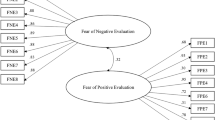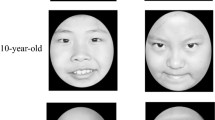Abstract
Gender differences in fear were examined in 693 Chinese children and adolescents. Subjects were asked to rate their own fears, the fears of their best friends, and the fears of “other” classmates using the Fear Survey Schedule for Children — Revised (Ollendick, 1983). Consistent with previous investigations in Western and Eastern countries, girls rated themselves as more fearful than boys. In addition, both girls and boys rated their best friends as similar in number, content, and intensity of fears. However, girls rated their classmates as less fearful than themselves or their best friends, while boys rated their classmates as more fearful than themselves or their best friends. Findings are discussed in terms of gender role expectations and similarity-attraction hypotheses.
Similar content being viewed by others
References
Campbell, S. B. (1986). Developmental issues in childhood anxiety. In R. Gittelman (Ed.),Anxiety disorders of childhood. New York: Guilford Press.
Dong, Q., Yang, B., & Ollendick, T. H. (1994). Fears in Chinese children and adolescents and their relations to anxiety and depression.Journal of Child Psychology and Psychiatry, 35 351–363.
Hsu, F. L. K. (1981).American and Chinese: Passages to differences. Honolulu: University Press of Hawaii.
King, N. J., Hamilton, D. I., & Ollendick, T. H. (1988).Children's phobias: A behavioural perspective. Chichester, England: Wiley.
Maccoby, E. E. (1980).Social development: Psychological growth and the parent-child relationship. New York: Harcourt Brace Jovanovich.
Maccoby, E. E., & Jacklin, C. N. (1974).The psychology of sex differences. Stanford, CA: Stanford University Press.
McCathie, H., & Spence, S. H. (1991). What is the revised Fear Survey Schedule for Children measuring?Behaviour Research and Therapy, 29 495–502.
Morris, R. J., & Kratochwill, T. R. (1983).Treating children's fears and phobias. New York: Pergamon Press.
Myers, D. (1993).Social psychology (4th ed.). New York: McGraw-Hill.
Neal, A. M., Lilly, R. S., & Zakis, S. (1993). What are African American children afraid of?: A preliminary study.Journal of Anxiety Disorders, 7 129–139.
Ollendick, T. H. (1983). Reliability and validity of the Revised Fear Survey Schedule for Children (FSSC-R).Behaviour Research and Therapy, 21 685–692.
Ollendick, T. H., & Hersen, M. (1993).Handbook of child and adolescent assessment. Boston: Allyn & Bacon.
Ollendick, T. H., & King, N. J. (1994). Fears and their level of interference in adolescents.Behaviour Research and Therapy, 32 635–638.
Ollendick, T. H., King, N. J., & Frary, R. B. (1989). Fears in children and adolescents: Reliability and generalizability across gender, age and nationality.Behaviour Research and Therapy, 27 19–26.
Ollendick, T. H., Matson, J. L., & Helsel, W. J. (1985). Fears in children and adolescents: Normative data.Behaviour Research and Therapy, 23 465–467.
Ollendick, T. H., Yule, W., & Ollier, K. (1991). Fears in British children and their relationship to manifest anxiety and depression.Journal of Child Psychology and Psychiatry, 32 321–331.
Scherer M. W., & Nakamura, C. Y. (1968). A Fear Survey Schedule for Children (FSS-FC). A factor-analytic comparison with manifest anxiety (CMAS).Behaviour Research and Therapy, 6 173–182.
Silverman, W. K., & Nelles, W. B. (1987). The influence of gender on children's ratings of fear in self and same-aged peers.The Journal of Genetic Psychology, 148 17–21.
Wenar, C. (1990). Childhood fears and phobias. In M. Lewis & S. M. Miller (Eds.),Handbook of developmental psychopathology. New York: Plenum Press.
Author information
Authors and Affiliations
Rights and permissions
About this article
Cite this article
Ollendick, T.H., Yang, B., Dong, Q. et al. Perceptions of fear in other Children and adolescents: The role of gender and friendship status. J Abnorm Child Psychol 23, 439–452 (1995). https://doi.org/10.1007/BF01447207
Issue Date:
DOI: https://doi.org/10.1007/BF01447207




